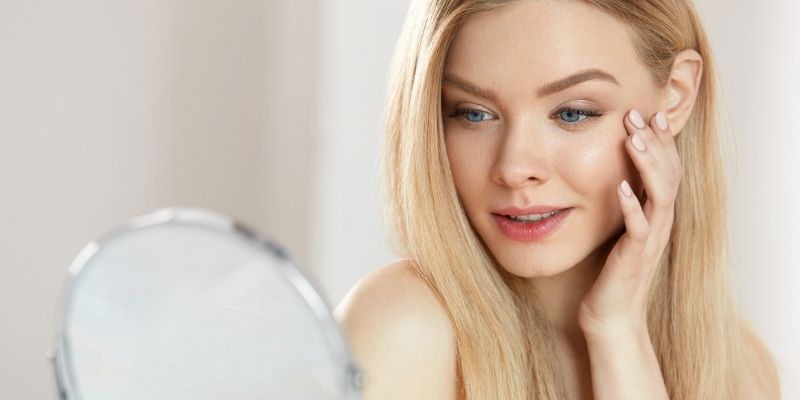If you are on a quest for a younger-looking, smoother, and brighter complexion, you have probably heard of alpha-hydroxy acids (AHAs).
However, while famous for their skin-rejuvenating effect, alpha-hydroxy acids are also known for causing side effects such as dryness, redness, irritation, flaking, and increased sensitivity to sunlight.
So, what’s an effective way to benefit from these powerful active ingredients without the downside?
In this article, I will explain how to apply them safely and what to use after alpha-hydroxy acids to achieve the best results without adverse reactions.

What Are Alpha Hydroxy Acids (AHAs)?
Alpha hydroxy acids are a group of plant and animal-derived acids used in various skincare products due to their ability to exfoliate the skin, brighten skin tone, improve texture, and reduce signs of aging.
AHAs are found throughout nature in sugarcane, sour milk, some fruits, and even nuts; however, AHAs used in dermatologic and cosmetic products are typically synthetically produced.
AHAs dissolve the protein bonds holding dead skin cells together, encouraging them to shed naturally and revealing brighter, smoother, and clearer skin from underneath.
Additionally, some AHAs can penetrate deeper into the pores, clear the accumulated cellular debris, and promote collagen production.
Here are some of them:
Glycolic Acid
Glycolic acid is renowned for its exfoliating, hydrating, and anti-aging properties.
It promotes cellular turnover and stimulates collagen formation, resulting in a brighter, smoother, and clearer complexion.
Furthermore, glycolic acid is effective in fading dark spots and age spots and reducing hyperpigmentation, making it a versatile skincare ingredient beneficial for most skin types and various skin concerns.
Lactic Acid
Lactic acid is another alpha-hydroxy acid derived from sour milk known for its skin rejuvenation properties.
It gently exfoliates the skin by breaking down and removing dead skin cells, which can lead to a smoother and more radiant complexion.
Additionally, lactic acid helps improve skin hydration levels, making it an excellent choice for those with dry or sensitive skin.
Mandelic Acid
Mandelic acid is alpha-hydroxy acid derived from bitter almonds renowned for its gentle exfoliation and anti-pigmentation properties.
It accelerates cellular turnover, removes dead skin cells, and reveals a brighter, more even complexion underneath.
Additionally, mandelic acid has antibacterial properties, making it an effective treatment for acne-prone skin.
Finally, mandelic acid has melanin-inhibiting properties, making it an effective treatment for post-inflammatory hyperpigmentation left from acne.
Understanding Skin Irritation from AHAs
Alpha hydroxy acids (AHAs) are widely appreciated for their exfoliating and skin-rejuvenating properties.
However, their effectiveness can sometimes come with a downside—the potential for skin irritation.
AHA-induced irritation primarily stems from the fact that AHAs can significantly decrease the skin’s pH level.
This disrupts the skin’s natural protective barrier, making it more susceptible to dryness, redness, and irritation.
Furthermore, the removal of the protective lipid layer on the skin surface by AHAs exposes the newer, more sensitive skin underneath, which can be more prone to irritation from environmental factors and other products.
Signs of AHA-induced irritation to look out for include:
- Redness
- Burning or stinging sensation
- Peeling and flaking
- Dryness
- Increased sensitivity to other skincare products
- Increased sensitivity to sunlight
It’s essential to recognize these signs early and adjust your skincare routine accordingly to prevent further irritation and barrier damage.
What To Use After Alpha Hydroxy Acids To Avoid Irritation?

AHAs at a concentration of 10% or less in skincare products are likely safe for most people when applied on the skin appropriately and as directed.
However, in some people, AHAs can make the skin slightly sensitive to sunlight; therefore, in some cases, they can cause mild skin irritation, redness, swelling, itching, and mild discoloration.
Here’s what you should do after using a product that contains alpha-hydroxy acids to avoid adverse effects:
Hydrating Serum
Applying a hydrating serum after using alpha-hydroxy acids can help replenish the moisture lost during exfoliation and prevent irritation.
Hydrating serums usually contain humectants such as glycerin and hyaluronic acid, which help draw water or moisture into the skin, thereby reducing dryness and keeping the skin strong, healthy, and clear.
To apply correctly, wait a few minutes after your AHA treatment to allow the acid to neutralize.
Then, gently press a few drops of the serum onto your face and neck until fully absorbed.
This step not only hydrates the skin but also aids in restoring the skin’s protective barrier, minimizing potential irritation from the AHAs.
Best serums to use after alpha-hydroxy acids:
- Best for dry skin: CeraVe – Hyaluronic Acid Serum
- Best for sensitive skin: Aveeno – Calm + Restore Triple Oat Serum
- Best for oily skin: Vichy – Mineral 89
Nourishing Moisturizer
After using alpha-hydroxy acids and applying a hydrating serum, it’s crucial to use a nourishing moisturizer to help repair and strengthen the skin’s barrier.
A moisturizer that contains emollient or occlusive ingredients will create a barrier on the skin’s surface and prevent the moisture from escaping.
Additionally, a moisturizer will also seal the hydration from the serum, which will further strengthen the skin’s barrier and increase its resistance to irritation.
Apply a pea-sized amount of moisturizer around five minutes after AHA, before the hydrating serum has fully dried out and while the skin is still damp, then gently massage it onto your face and neck in upward strokes.
Look for moisturizers that contain ingredients like ceramides, fatty acids, and plant oils that can help restore the skin’s natural protective barrier.
Best moisturizers to use after alpha-hydroxy acids:
- Best for dry skin: CeraVe – PM Facial Moisturizing Lotion
- Best for sensitive skin: La Roche-Posay – Cicaplast Balm B5
- Best for oily skin: Neutrogena – Hydro Boost Night Moisturizer
Sunscreen
Applying sunscreen after using alpha hydroxy acids (AHAs) is non-negotiable because AHAs increase the skin’s sensitivity to sunlight, elevating the risk of sun damage.
This heightened sensitivity means that unprotected exposure to UV rays can lead to quicker and more intense sunburns, premature aging, and an increased risk of skin cancer.
Additionally, since AHAs work by exfoliating the upper layer of the skin, the newer skin exposed is more vulnerable and needs protection to maintain its health and prevent hyperpigmentation.
Therefore, using a broad-spectrum sunscreen with at least SPF 30 is essential to prevent skin damage and shield the new, delicate skin from harmful UV rays while preserving the benefits achieved by the AHA treatment.
Best sunscreens to use after alpha-hydroxy acids:
- Best for dry skin: Bondi Sands – Fragrance-Free Daily Sunscreen SPF 50
- Best for sensitive skin: Aveeno – Positively Mineral Sensitive Skin Sunscreen SPF 50
- Best for oily skin: EltaMD – UV Clear SPF 46
Alternatives to AHAs for Sensitive Skin
If you have sensitive skin, you may find that AHAs are too harsh for your skin and cause irritation even when using the proper aftercare.
In this case, it’s best to avoid using AHAs altogether and opt for other gentler forms of exfoliation like:
Polyhydroxy Acids (PHAs)
Polyhydroxy acids (PHAs) offer a milder alternative to AHAs, making them suitable for sensitive skin types prone to irritation.
These acids work on the skin’s surface to exfoliate dead skin cells without penetrating deeply, thereby reducing the potential for inflammation and sensitivity.
Unlike AHAs, PHAs also have antioxidant properties and enhance the skin’s moisture retention, contributing to a fortified skin barrier.
This gentle mode of action makes PHAs an excellent choice for those seeking the benefits of exfoliation without the associated risks of irritation.
Beta Hydroxy Acids (BHAs) for Oily Skin
Beta hydroxy acids (BHAs), primarily salicylic acid, stand out as an effective alternative to AHAs for those with oily and acne-prone skin.
BHAs are oil-soluble, allowing them to penetrate deeper into the pores to remove excess sebum and dead skin cells and improve overall skin texture.
This deep pore-cleansing action not only helps reduce acne but also refines large pores, setting BHAs apart as a preferred choice for oily and acne-prone skin types seeking gentle exfoliation without exacerbating skin sensitivity.
Enzymatic Exfoliants
Enzymatic exfoliants offer a mild yet effective option for those seeking gentler exfoliation.
Unlike AHAs and BHAs, these exfoliants break down the proteins in dead skin cells, leading to a smoother skin surface without lowering the skin’s pH balance.
This method is particularly beneficial for sensitive skin types, as it minimizes the risk of irritation.
What Should You Not Mix With Alpha Hydroxy Acids?

When using Alpha Hydroxy Acids (AHAs) in your skincare routine, there are certain ingredients you should avoid combining them with to prevent potential skin irritation:
- Retinol: Both retinol and AHAs can increase cellular turnover. Using them together can lead to over-exfoliation and adverse effects such as dryness, sensitivity, and barrier damage.
- Vitamin C: When mixed with vitamin C, AHAs can interfere with the skin’s pH levels and destabilize the efficacy of the antioxidant, ultimately reducing its effectiveness or causing adverse effects.
- Benzoyl Peroxide: Commonly used in acne treatments, benzoyl peroxide can be too harsh on the skin when combined with AHAs.
- Physical Exfoliating Scrubs: Using physical exfoliants after applying AHAs may lead to over-exfoliation, which can damage your skin.

My name is Simone and I am a certified skin specialist. I created this website to teach my readers how to take great care of their skin and I also like to occasionally share my honest opinions on skincare products I’ve tried. You can learn more about me here.
